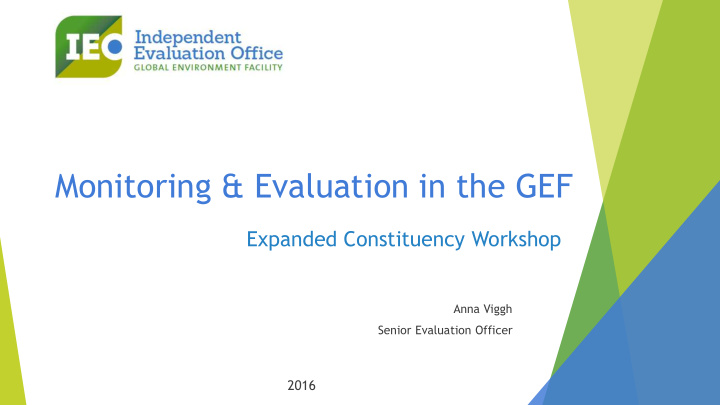



Monitoring & Evaluation in the GEF Expanded Constituency Workshop Anna Viggh Senior Evaluation Officer 2016
Outline Part 1: M&E in the GEF Partnership Part 2: Role of Country Stakeholders in Project M&E Part 3: A Case Study Part 4: Your Inputs into the Sixth Comprehensive Evaluation
PART 1 M&E in the GEF Partnership
Guided by the M&E Policy M&E in the GEF GEF Council GEF STAP GEF IEO Secretariat GEF Agency Evaluation GEF Agencies Offices Participating Countries Country Policy, standard-setting and/or oversight function Stakeholders Reporting or provision of information
GEF Independent Evaluation Office • To enhance global environmental benefits through excellence, Mission independence, and partnership in monitoring and evaluation • Independent evaluation • Setting of minimum standards (normative) Functions • Quality control (oversight) • Knowledge sharing and dissemination
Independent Evaluations and Methods Annual Performance Reports Thematic evaluations such as Multiple Benefits, Programmatic Approaches, Multiple Benefits and Institutional Issues Methods include GIS, Remote Sensing, Big Data Analytics Mainstreaming Gender, Stakeholder Engagement, Resilience, Private Sector
Purpose of M&E in the GEF Monitoring and to assess • Evaluation (M&E) contribution to GEBs promote accountability to serve as basis for • and learning decision-making
What is the difference between Monitoring and Evaluation?
Monitoring Is our activity on track? Monitoring uses systematic collection of data to keep activities on track. Forms of monitoring: Monitoring of environmental conditions and stressors Monitoring of progress toward project outcomes Monitoring of project performance
Evaluation Are we doing the right thing? Are we doing things right and efficiently? Are there better ways of doing it? Evaluation is a systematic assessment of an activity (program, strategy, etc.) that assesses relevance , effectiveness , efficiency, Project/Program Evaluations: results and sustainability . Mid-term Terminal Other forms of evaluation: impact, process, performance, thematic, corporate
What should we Monitor? A variable that tracks the changes connected to an intervention Inputs Activities Outputs Outcomes Impacts Indicators for IMPLEMENTATION Indicators for RESULTS Specific SMART Measurable Indicators Achievable and Attributable Relevant and Realistic Time-Bound, Timely, Trackable, and Targeted
M&E starts with a THEORY OF CHANGE Inputs Activities Outputs Outcomes Impacts Context Assumptions How do we achieve IMPACT?
PART 2 Role of Country Stakeholders in Project M&E
Areas for Your Participation M&E Plan design and implementation Terminal evaluations
M&E Plan M&E plan by CEO endorsement for FSP and CEO approval for MSP Project logical frameworks should align with GEF focal area results frameworks M&E Plan should include: SMART indicators Baseline data for M&E by CEO endorsement Identification of necessary reviews, e.g. Mid-term Reviews (where required or foreseen) and Terminal Evaluations Organizational set-up and budget for M&E
Good Practices Finding: Strong link between good M&E and project outcomes Clearly defined responsibilities for monitoring and evaluation activities Dedicated budget for each M&E component M&E plan designed to provide timely and relevant information M&E plan linked to the project’s theory of change Tracking tools integrated into M&E plan Active participation of stakeholders in M&E implementation Stakeholder training in the project M&E system (including those who are supposed to use the findings) Sharing M&E findings with broad groups of stakeholders Source: GEF Annual Performance Report 2013
What has been your experience in design and implementation of M&E Plans? Are there lessons to share?
Project Terminal Evaluations An important source of information on projects Results: Outputs, outcomes and progress towards impact Implementation, execution, and project cycle-related information Project finances including co-financing Recommendations and lessons for the future About 1000 terminal evaluations Reporting at the project portfolio level completed so far Terminal evaluation may be accessed @ (APR, AMR) http://www.thegef.org/gef/gef_project Input to other evaluations, e.g. STAR’s s_funding or through PMIS performance index
M&E Policy on Terminal Evaluations All full-size projects and programs will be evaluated at the end of implementation. Evaluations should: Be independent of project management or reviewed by GEF Agency evaluation unit Apply evaluation norms and standards of the GEF Agency Assess, as a minimum, outputs and outcomes, likelihood of sustainability, compliance with design and implementation Contain basic project data and lessons on the evaluation itself (including TORs) Should be sent to GEF IEO within 12 months of completion of project/program Guidelines for Terminal Evaluations
A Good Terminal Evaluation Evaluator is independent from design team (unbiased) Discusses outcomes and results Consistent and complete in information provided Discusses issues related to project sustainability Provides information on project finance and co-financing Provides information on M&E plan and the use of monitoring information Draws lessons and recommendations based on the project experience Other qualities Balanced judgment Timely Transparent process
What experiences have you had with Terminal Evaluations? Any good practices to share? Any Issues?
Pulling it all together: A CASE STUDY
Group Work: Case Study (20 minutes) Plenary Report out: 15 minutes What needs to happen for “effective conservation” to be achieved? For Component 3, identify: SMART!! 1) Outcomes 2) Outcome indicators 3) Elements of monitoring and evaluation plan
LOOKING AHEAD: Sixth Comprehensive Evaluation of the GEF: GEF in the Changing Environmental Finance Landscape To provide inputs to the replenishment process on the extent to which GEF is achieving its objectives GEF support can be improved OPS6 Report: Final report: FALL 2017
Share your perspective! Discuss series of questions in small groups Guidance of the conventions Trends in ownership and country drivenness Trends in performance issues Involvement of civil society and private sector Record comments on provided forms (one per country)
Thank you! For more information, visit www.gefieo.org
Recommend
More recommend